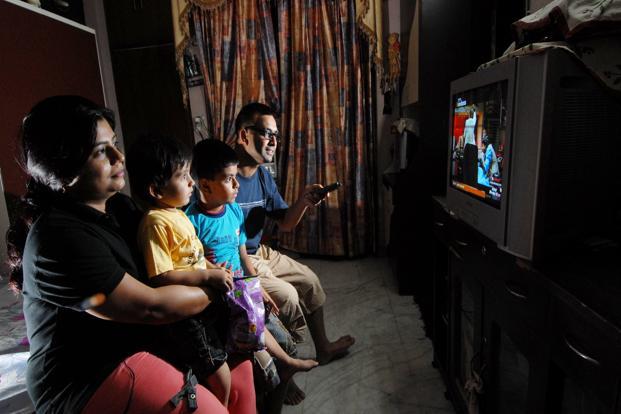
Of total television viewership, the share of news in India was 7%, according to data for week 19 from television monitoring agency Barc India. Photo: Priyanka Parasher/Mint
Is it sensationalism or credibility that brands look for when they buy ad spots on news channels? Or do they just blindly follow ratings?
The head of a prominent entertainment channel who has worked at news channels in the past recalls the days advertising on news channels was bought on perception. The perception of being respectable and credible fetched a premium on advertising rates even if the channel was not top of the heap in terms of viewership.
The executive rues what’s happened to news channels. The way news has shaped up is disturbing, he says. There is no semblance of balance or any attempt at credibility.
Media industry experts say that ad spots on news channels are now bought on the basis of channel rankings.
According to Sanjay Sarma, chief executive of strategic branding firm Design Worldwide, “Increasingly, the definition of credibility is blurring and TRPs (television ratings points) drive decisions. Logically, a brand should avoid getting lost in the media clutter and align with a set of channels and programming mix that reflects its own positioning. But very few practice it.”
The focus on ratings, while understandable, isn’t all that logical. The news genre is niche in terms of viewership. Of total television viewership, the share of news in India was 7%, according to data for week 19 from television monitoring agency Broadcast Audience Research Council (Barc) India. Of this, the share of Hindi news was 43%.
However, of the total news genre category, the share of English news, which averages around a minuscule 0.4%, grew in week 19 to touch 1%. That can, perhaps, be attributed to the launch of Republic TV, an English news channel from Arnab Goswami’s media venture ARG Outlier Media Pvt. Ltd and Asianet News Service—Rajya Sabha MP Rajeev Chandrasekhar’s company, who is also an investor in the firm.
According to media industry estimates, India is currently home to over 300 news channels of which Barc measures 145. Obviously, the news audiences are highly fragmented. So, the competition is intense and news has become a commodity.
News is much cheaper to buy compared to entertainment channels. News channels do not have the same magnitude of viewership as entertainment channels (soaps and reality shows), sports channels (cricket broadcasts), and movie channels (blockbusters) that tend to have appointment viewing. So, while some specific news programmes, like the News Hour (on Times Now), for instance, do display characteristics of appointment viewing, there is usually no fixed time to catch the news on television.
According to Alok Rakshit, president Aidem Ventures, an independent ad sales firm, advertisers see news as a reach builder and frequency optimizer, which means it helps the ad reach more people and can be shown several times. “On general entertainment channels, you cannot have the same frequency of ads spots as it is many times costlier,” he says.
Cost is one reason why news channels are popular. The head of a media buying agency, who declined to be named, says that India is a news-hungry nation and the news genre is very popular with advertisers. “Something exciting is happening in the country all the time and news amplifies the events,” he says.
The genre, however, is crowded and the cumulative viewership of news is insignificant as a percentage of total viewership. “So, competition is intense and channels go into hyper mode and get involved in a game of one-upmanship,” he says, adding that to buy spots on news, advertisers look for viewership, the buzz around a channel and also the response they get from ads aired on the channel.
Does credibility matter?
“Advertisers are not any different from viewers. Some shy away from sensationalism while others say ‘this is popular with the masses’ so we must advertise. There is no one view on what is good or bad. Besides, credibility is subjective,” he feels.
Samit Sinha, brand expert and managing partner at Alchemist Brand says that sensationalism blurs the line between news and entertainment, which makes media owners feel that the more sensational the news becomes, the more share of eyeballs it will seize from entertainment genres resulting in higher viewership. “That’s why we find a lot of news programmes have morphed into theatre, with Arnab Goswami as its most conspicuous exemplar.”
That might turn away some advertisers, he admits, but ultimately, viewership numbers will prevail.
Shuchi Bansal is Mint’s media, marketing and advertising editor. Ordinary Post will look at pressing issues related to all three. Or just fun stuff.
[“Source-ndtv”]
